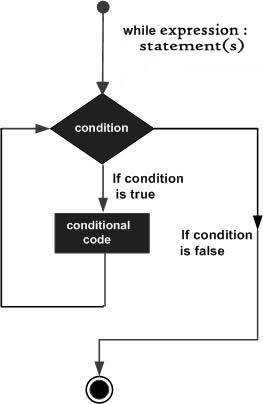【Python基础】while循环语句
2020-12-13 03:40
标签:code file less 无限 ace 开发 oar 跳过 循环条件 Python 编程中 while 语句用于循环执行程序,即在某条件下,循环执行某段程序,以处理需要重复处理的相同任务。其基本形式为: while 判断条件: 执行语句…… 执行语句可以是单个语句或语句块。判断条件可以是任何表达式,任何非零、或非空(null)的值均为true。 当判断条件假false时,循环结束。 执行流程图如下: 实例: 以上代码执行输出结果: while 语句时还有另外两个重要的命令 continue,break 来跳过循环,continue 用于跳过该次循环,break 则是用于退出循环,此外"判断条件"还可以是个常值,表示循环必定成立,具体用法如下: 无限循环 如果条件判断语句永远为 true,循环将会无限的执行下去,如下实例: 以上实例输出结果: 注意:以上的无限循环你可以使用 CTRL+C 来中断循环。 循环使用 else 语句 在 python 中,while … else 在循环条件为 false 时执行 else 语句块: 以上实例输出结果为: 简单语句组 类似 if 语句的语法,如果你的 while 循环体中只有一条语句,你可以将该语句与while写在同一行中, 如下所示: 注意:以上的无限循环你可以使用 CTRL+C 来中断循环。 Python更多课程:阿里云大学——开发者课堂 【Python基础】while循环语句 标签:code file less 无限 ace 开发 oar 跳过 循环条件 原文地址:https://www.cnblogs.com/ciip/p/11083418.html
#!/usr/bin/pythoncount = 0while (count
print ‘The count is:‘, count
count = count + 1print "Good bye!"
The count is: 0The count is: 1The count is: 2The count is: 3The count is: 4The count is: 5The count is: 6The count is: 7The count is: 8Good bye!
# continue 和 break 用法i = 1while i
i += 1
if i%2 > 0: # 非双数时跳过输出
continue
print i # 输出双数2、4、6、8、10i = 1while 1: # 循环条件为1必定成立
print i # 输出1~10
i += 1
if i > 10: # 当i大于10时跳出循环
break;
#!/usr/bin/python# -*- coding: UTF-8 -*-var = 1while var == 1 : # 该条件永远为true,循环将无限执行下去
num = raw_input("Enter a number :")
print "You entered: ", numprint "Good bye!"
Enter a number :20You entered: 20Enter a number :29You entered: 29Enter a number :3You entered: 3Enter a number between :Traceback (most recent call last):
File "test.py", line 5, in
#!/usr/bin/pythoncount = 0while count
print count, " is less than 5"
count = count + 1else:
print count, " is not less than 5"
0 is less than 51 is less than 52 is less than 53 is less than 54 is less than 55 is not less than 5
#!/usr/bin/pythonflag = 1while (flag): print ‘Given flag is really true!‘print "Good bye!"